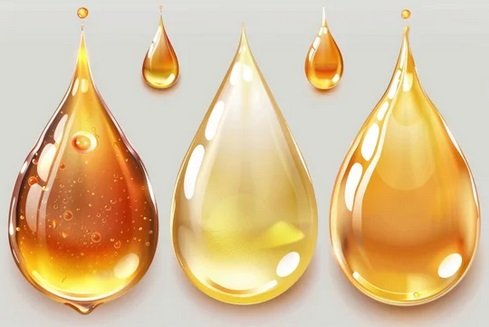Skin Care Health
The Power of Fatty Acids: The benefits and drawbacks for your skin [Part 2]
In a previous blog post I discussed saturated and unsaturated fats with further breakdown into the monounsaturated and polyunsaturated fats to include the wonderful omega fatty acids. Now, we’re going to go a bit deeper, investigating twelve types of fatty acids that make up different saturated and unsaturated fats in their plant and animal forms.
Fatty acids are essential building blocks for healthy skin, playing a key role in hydration, inflammation control, and maintaining the skin’s protective barrier. Found naturally in various plant and animal oils, different fatty acids offer unique benefits depending on their structure and properties. From moisturizing and softening to fighting acne and reducing inflammation, they cater to a wide range of skin types and concerns. However, not all fatty acids are created equal—some can clog pores or cause irritation, while others help balance and nourish even the most sensitive skin. Understanding the most popular fatty acids and their effects can help you choose the right ingredients for your skincare needs.
There are more than 450 different fatty acids that have been isolated in plants with some being more common than others. Let’s take a dive into some different types found in plant oils and animal fats.
1. Linoleic Acid (Omega-6)
- Benefits: Helps maintain the skin’s moisture barrier, reducing water loss and improving hydration. It also has anti-inflammatory properties, making it beneficial for acne-prone skin.
- Drawbacks: None for most skin types, but may not be ideal for very dry skin if used alone.
- Found in: Sunflower oil, safflower oil, hemp seed oil, evening primrose oil
2. Oleic Acid (Omega-9)
- Found in: Olive oil, avocado oil, almond oil, argan oil, animal fats
- Benefits: Highly moisturizing and helps to soften the skin. Good for dry, aging, or dehydrated skin.
- Drawbacks: Can be too heavy and pore-clogging for acne-prone or oily skin.
3. Palmitic Acid
- Benefits: Helps to restore the skin’s barrier and protect against environmental damage. It’s an emollient that softens and soothes the skin.
- Drawbacks: Can be comedogenic (pore-clogging) for acne-prone skin.
- Found in: Palm oil, coconut oil, shea butter, animal fats
4. Stearic Acid
- Benefits: Acts as an emollient, helping to soften and smooth the skin. It also has cleansing properties and is commonly used in soaps.
- Drawbacks: Generally safe, but may feel heavy for some skin types, particularly oily or acne-prone skin.
- Found in: Cocoa butter, shea butter, coconut oil, palm oil
5. Gamma-Linolenic Acid (GLA, Omega-6)
- Benefits: Anti-inflammatory and helps improve skin elasticity, moisture retention, and smoothness. Excellent for dry, aging, or inflamed skin.
- Drawbacks: Generally safe and loved by all skin types but some people may be sensitive to certain oils containing GLA.
- Found in: Borage oil, evening primrose oil, hemp seed oil
6. Arachidonic Acid (Omega-6)
- Benefits: Supports skin repair and helps reduce inflammation.
- Drawbacks: Can exacerbate inflammation if overused, especially in those with acne-prone skin.
- Found in: Animal fats, fish oils
7. Lauric Acid
- Benefits: Has antibacterial and antimicrobial properties, making it excellent for acne-prone skin. It’s also a good moisturizer.
- Drawbacks: Can be too heavy or comedogenic for some, especially if used in high concentrations.
- Found in: Coconut oil, palm kernel oil, babassu oil
7. Myristic Acid
- Benefits: Good cleansing agent, often used in soaps and cleansers for its ability to remove oils and dirt.
- Drawbacks: Can be drying if used in high concentrations or on sensitive skin.
- Found in: Nutmeg butter, coconut oil, palm kernel oil
8. Palmitoleic Acid (Omega-7)
- Benefits: Naturally present in human sebum, making it great for skin regeneration and repair. Helps prevent moisture loss and is beneficial for aging or damaged skin.
- Drawbacks: None significant, but it’s a richer oil and may not be suitable for very oily skin types.
- Found in: Macadamia oil, sea buckthorn oil
10. Caprylic/Capric Acid
- Benefits: Offers moisturizing and skin-soothing properties. It has antimicrobial properties and is often used in products for its lightweight and fast-absorbing nature.
- Drawbacks: Generally safe, but some may find coconut-derived ingredients comedogenic.
- Found in: Coconut oil, palm kernel oil
11. Behenic Acid
- Benefits: Acts as a good emollient, softening the skin and improving texture. Often used in anti-aging products for its conditioning properties.
- Drawbacks: Can be too heavy for oily or acne-prone skin.
- Found in: Moringa oil, peanut oil
12. Erucic Acid (Omega-9)
- Benefits: Highly moisturizing and helps to improve the skin’s texture. It has a similar texture to sebum, making it beneficial for balancing skin oils.
- Drawbacks: Can be irritating or sensitizing for some people, especially in large amounts.
- Found in: Mustard oil, jojoba oil, rapeseed oil
Remember, plant and fat oils have a mix of different fatty acids with varying concentrations. In example, rosehip seed oil has 54% linoleic acid, 19% linolenic acid, and 14% Oleic acid. An animal fat example, tallow, has 43% oleic, 32% palmitic acid, 20% stearic acid, and 3% linoleic acid. (Source: National Institutes of Health) On skincare labels you’ll see the name of the fat as its original name or International Nomenclature Cosmetic Ingredient (INCI) name.
In addition, skincare manufacturers should adjust the amount of these oils to achieve the best results for their intended use. For example, coconut oil is beneficial for body skin in small percentages (20% or less) but is generally not recommended for facial use due to its comedogenic (pore-clogging) properties. A better option for facial applications would be fractionated coconut oil, also known as medium-chain triglycerides (MCTs), but it should still be used sparingly, at less than 10% of the total formulation.
These fatty acids offer a range of skin benefits, and their suitability depends on your skin type and needs. Oily and acne-prone skin generally benefits from lighter oils high in linoleic acid, while dry and mature skin thrives on oils rich in oleic acid or palmitoleic acid.
A simple google search can provide the fatty acid profile of any oil or fat in your skincare products. Always check your source. A name like Annie’s Farmfresh skin might not be reliable.
Now as you go about your day see something that inspires, share something that uplifts, and act on something that will make a difference. Kindness spreads kindness with momentum. ![]()

